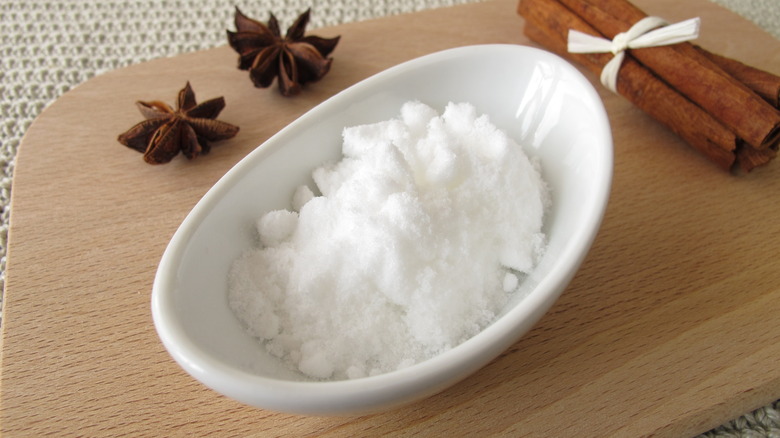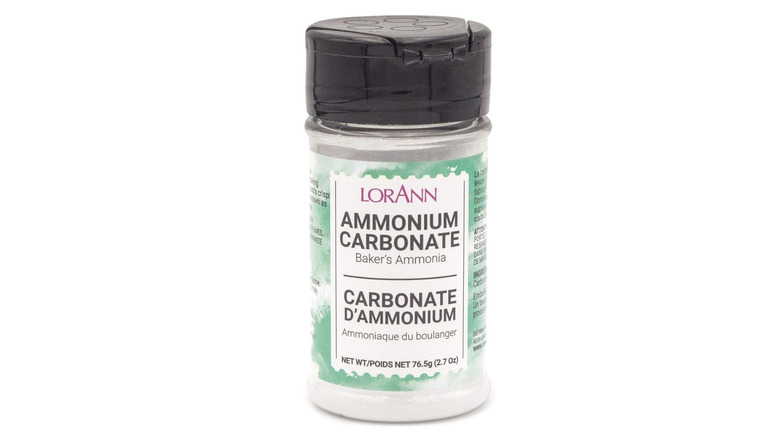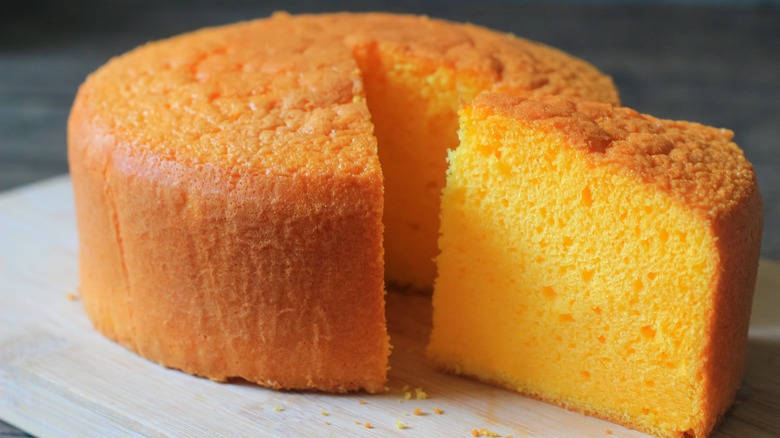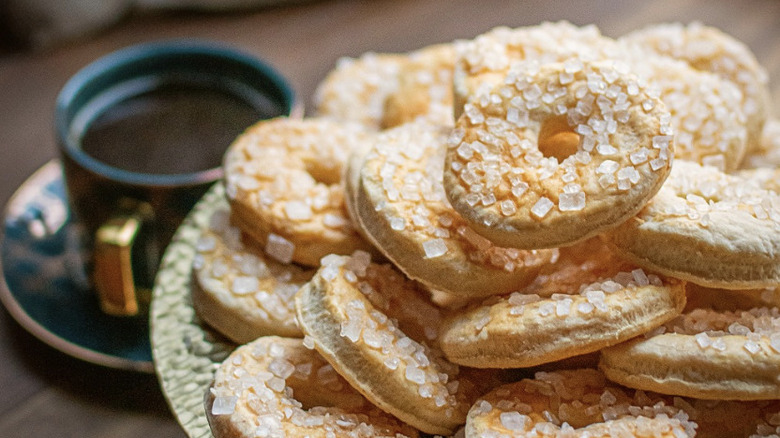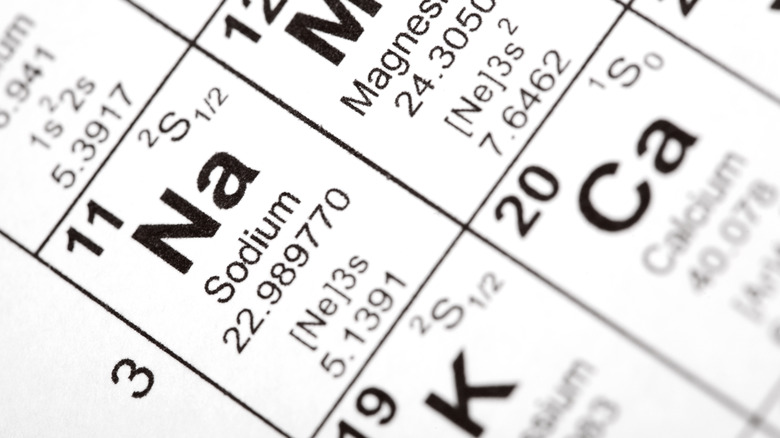Why People Don't Use Baker's Ammonia Anymore And Why It Should Make A Comeback
We may receive a commission on purchases made from links.
Called by many names — including baker's salt, hartshorn salt, and ammonium carbonate — baker's ammonia has fallen out of favor since a version of modern day baking powder first came on the scene in the mid 19th century. While the leavening agent used to form the basis of many recipes, today baker's ammonia is mostly utilized in some German and Scandinavian baking recipes. One of these is German springerle biscuits. Often embossed with pictures of animals and Biblical scenes, the intricate-looking cookies are usually baked just before Christmas.
Interestingly, when it first surfaced in the 1830s, baker's ammonia was derived from hartshorn, a substance obtained by grinding nitrous products such as the horns of harts, or male deer. The same compound can also be found in hair and nails, but we doubt those were as commonly used to make ammonium carbonate. Luckily baker's ammonia can be produced with less dramatic methods, namely through chemical reactions involving ammonium chloride.
While baker's ammonia isn't used in modern cooking, the product possesses a number of unique characteristics that can make it preferable to baking powder in certain recipes. Keep reading to find out why this ingredient went out of style and why you might still want it in your kitchen.
What is baker's ammonia?
While for some the word ammonia may bring to mind household cleaning products, baker's ammonia has very little in common with the disinfectant aside from its smell. Instead, it's used as a leavening agent in baking, imparting cookies and crackers with a wonderfully crisp and airy texture.
Baker's ammonia is made up of ammonium salt, which turns into carbon dioxide when combined with the moisture in baked goods and subjected to heat above 104 degrees Fahrenheit. This is the process that creates the ingredient's leavening effect. Baker's ammonia can be obtained in either lump or powder form. Lumpy ammonium carbonate isn't ready for use. Instead, it needs to be crushed into powder with either a rolling pin or a mortar and pestle. Always store baker's ammonia in an airtight container, as the compound can evaporate over time if exposed to air.
As baking powder became more popular, baker's ammonia has disappeared from grocery store shelves. As such, it may be somewhat tricky to find at your local supermarket. Even some commercial bakery suppliers don't always stock it. Your best bet for getting your hands on baker's ammonia is ordering it online.
Against: Baker's ammonia has a strong smell
One of the reasons why baker's ammonia has lost the popularity war to baking powder, is its distinctive ammonia smell. After all, there's a good reason why it was the main ingredient in smelling salts, thought to have an odor strong enough to revive those about to faint.
The unpleasant odor is created because ammonium carbonate divides into two chemicals when heated. One of these is carbon dioxide, which raises the dough, and the other is ammonia, which stinks up your kitchen. Luckily, the smell is fast to dissipate and doesn't usually leave the baked goods with any odor.
Despite the odor, many home cooks swear by baker's ammonia. One reviewer who used the product to make Christmas cookies explains: "It worked great, but it did smell quite a bit. Some during preparation, but a lot during baking. Not exactly Christmas-like, but the results were worth it." Another baking enthusiast who tried to recreate the biscuits made by her mother agrees, saying, "Though it does stink to high heaven once it gets in the batter, the smell dissipates and what's left behind are high-rising crispy anise cookies like my husband remembered. I was delighted that he was delighted and would go through the brief but obnoxious ammonia smell again just to see the smile on his face."
Against: Modern recipes often call for other leavening agents
The ingredient lists in most modern recipes for baked goods include either baking soda or baking powder. Ready to use straight out of the box, baking powder is simply baking soda mixed with cream of tartar, which is a byproduct of winemaking. To substitute baking powder in a recipe that requires baking soda, you'll need to double or triple the amount of baking powder. Conversely, if the recipe calls for baking powder and you only have baking soda, you'll need to mix it with cream of tartar.
Some recipes — particularly for traditional European or Scandinavian baked goods — may still call for baker's ammonia. For instance, Polish amoniaczki biscuits and Swedish drömmar "dream" cookies are likely to require the ingredient. Notably, food historian and author, Rae Katherine Eighmey, told the Star Tribune that some antiquated recipes fail to provide the kind of standardized measurements we are used to. A case in point is a recipe calling for "five cents of baker's ammonium."
There are differing views about the appropriate ratios for substituting baker's ammonia with baking powder or baking soda. While we can't guarantee the final results, one Reddit user suggests substituting one teaspoon of baker's ammonia for two teaspoons of baking soda. Since precision is crucial here, we recommend caution. Adding too much baker's ammonia to your baking may not only mess up the leavening process but also result in a nasty ammonia smell or flavor in the final product.
Against: Baker's ammonia isn't ideal for baking cakes due to their moisture content
Perhaps the greatest reason why baker's ammonia is no longer popular are its limited applications. When heated, baker's ammonia transforms into two chemicals, namely carbon dioxide and ammonia. While carbon dioxide raises the dough, the ammonia needs some time to evaporate. If the dough contains too much moisture, baker's ammonia won't have enough time to bake out and will leave the final product with an unpleasant ammonia taste and odor. According to ScienceDirect, more than five percent of moisture in dough is enough to stop the ammonia gas from dissipating completely from the product during baking.
Baker's ammonia is not suitable for making muffins and cakes since they both have a high moisture content. One home baker has summed this up perfectly in a forum post, saying, "It's not so much that it's unwise to use [baker's ammonia] in recipes that don't call for it as to restrict its use to thin and dryer scenarios. [...] The reason for this is that ammonium carbonate (baking ammonia) will be converted to ammonia (a gas) in the heat of the oven. Ammonia is hydrophilic, and using it in a thick moist item like a cake can mean that traces of it are left behind. It won't poison you but it'll make your food taste bitter and gross."
For: Baker's ammonia is great for making low-moisture baked goods
Baker's ammonia is a great raising agent, provided it's used in a way that ensures that the ammonia has enough time to evaporate from the baked goods. If the gas doesn't fully escape during the baking process, you'll likely end up with pungent-smelling and tasting biscuits. This is why it's best to use baker's ammonia only for products with a porous texture and little moisture.
Baker's ammonia is especially effective when used as a leavening agent for dough with a moisture content lower than 3%. Furthermore, the ingredient is well suited to baking goods with a large enough surface area to let the ammonia gas dissipate relatively quickly at high temperatures. Baker's ammonia also tends to increase the pH level of baked goods, which, in turn, can increase browning — an effect that can be desirable in certain biscuit recipes. Finally, ammonium carbonate has good bench tolerance since it's not very reactive at room temperature, giving biscuits a longer shelf life.
For: Baker's ammonia can add a unique texture to baked goods
Baker's ammonia really shines in biscuits recipes, particularly those with a crisp and airy texture. As one cookie enthusiast puts it: "There's nothing that compares to the crisp texture of a cookie baked with baker's ammonia. (At least nothing I've ever come across, and I've eaten many cookies in my lifetime.)" This is precisely why in Europe the ingredient often appeared in traditional recipes for thin and crispy cookies, biscotti, and crackers.
Baker's ammonia can give biscuits a uniformly crisp and brittle texture. Conversely, if you used baking powder in the same recipe, the biscuits would be likely to end up having a crispy exterior and a somewhat chewy interior. Furthermore, the crumb created by baker's ammonia tends to be coarser and more open than that made by adding baking powder to a recipe. Food historian and cookbook author, Rae Katherine Eighmey, used baker's ammonia to make lemon crackers, with outstanding results. In an interview with the Star Tribute she describes the texture of the crackers as astounding, adding, "Tender isn't the right word; it's subtle, it's flaky. I struggle to describe it. It has teeny tiny pockets of crispiness."
For: Baker's ammonia doesn't have an unpleasant aftertaste
Provided that the ammonia has completely evaporated in the oven, baker's ammonia will leave your baked goods with a neutral flavor. This is unlike baking soda, which can give your culinary creations a metallic flavor. According to Rae Katherine Eighmey, individuals with "sensitive taste buds" are more prone to detecting this aftertaste, which she describes as soapy or alkaline (via Star Tribune).
Baking soda requires acidic ingredients, such as buttermilk, vinegar, lemon juice or sour cream to do it magic. More specifically, these ingredients prompt the release of carbon dioxide, which, in turn, makes the dough rise. Since they neutralize each other, adding too much baking soda or not enough acid can result in baked goods with a bitter or metallic taste. The best way to avoid this tragedy is to follow your baking recipe to a T and measure ingredients with an accurate kitchen scale.
If you happen to put too much baking soda into your dough, there's no need to panic — the situation can still be remedied. To counteract the alkaline properties of the leavening agent, add a little extra acidity to the dough. Alternatively, increase the amounts of the other ingredients to ensure that the recipe has the correct ratios.
For: Baker's ammonia is gluten free and has much less sodium than baking powder
Since the leavening powers of baker's ammonia are the product of a chemical reaction between ammonia and carbon dioxide, the product is inherently gluten free. Baking powder, on the other hand, usually contains starch. If you're gluten intolerant or suffer from celiac disease, it's best to read the label on baking powder products to ensure that they don't contain starch made from wheat. Baking powders that contain potato starch or pure cornstarch are normally gluten-free.
As we become more educated about the dangers of sodium, many of us are seeking ways to reduce its intake. Baker's ammonia contains much less sodium than baking powder. However, while ammonium carbonate contains little to no sodium, this isn't the case for baking powder, which is packed with salt. In fact, each tablespoon of baking powder contains around 1,500 milligrams of sodium. Considering that the World Health Organization recommends that adults consume a maximum of 2,000 milligrams of sodium per day, this is a substantial amount.
